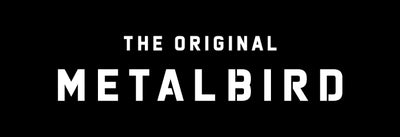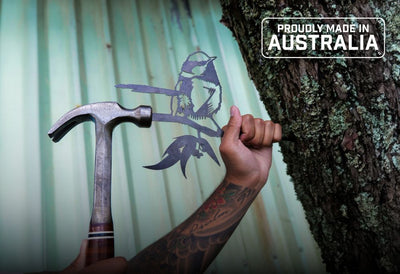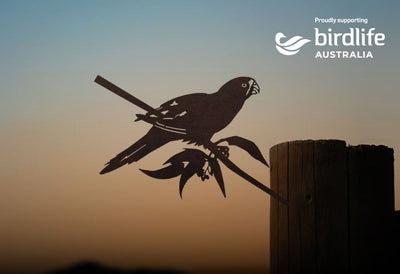There’s a saying in the trades:
"Measure twice, cut once."
In my shed, it was more like:
"Eyeball it, cut it, swear, cut it again, cry a bit."
That’s how the first Metalbirds were made. Not in a design studio with CAD software and ergonomic chairs, but in a cold shed with a blunt grinder, a chunk of Corten steel, and a stubborn streak.
People look at our silhouettes now and think they’ve always been this clean and simple. But behind every perfect bird is a pile of mutant bat prototypes and birds that looked more like flying teapots.
This is the real story of what it takes to make a bird out of steel... and why it matters that we still do it the hard way.
The First Cut Is the Deepest (and the Worst)
When I started Metalbird, I didn’t have a plan.
I had an idea:
"Wouldn’t it be cool if birds just appeared on lampposts and fences and made people look up?"
So I grabbed some steel, sketched out a bird, and fired up the grinder.
The first one? It was meant to be a Blackbird.
What I ended up with looked like a bat that had flown into a window.
Too fat in the body. Wings too short. Beak like a carrot.
But I stuck it on a lamppost anyway. And you know what? People loved it. Not because it was perfect, but because it made them stop and smile.
Why Making Birds Is Harder Than It Looks
Birds are all about movement. They don’t just sit still... they flutter, tilt, preen, and dart. Capturing that in a static piece of steel is harder than you’d think.
You can’t just trace a photo and call it done. Trust me, I tried.
If you cut the silhouette wrong, you end up with:
-
A sparrow that looks like a rugby ball.
-
A fantail that looks like a mop.
-
A kingfisher with a beak so long it could skewer a fish and the fisherman too.
It took me years to figure out how to suggest movement in a still shape.
It’s about getting the balance right. The tilt of the head. The spread of the tail. The way the feet perch, not clamp.
And then you have to make sure the thing actually works in steel. Too thin, and it’ll snap. Too thick, and it looks like you’ve got a doorstop in the tree.
Why We Still Do It by Hand
These days, we could outsource the design. Get a graphic designer to whip up some perfect silhouettes on a computer.
But that’s not how we work.
Every new Metalbird starts the same way it did in the shed... with pencil, paper, and a whole lot of mucking around.
We sketch. We cut prototypes. We stare at them from different angles. We stick them in the garden and watch how they look at dawn, at dusk, in the rain.
Sometimes we scrap the design and start again.
Because we’re not just making shapes. We’re making stories.
The Emotional Shape of a Bird
When you design a Metalbird, you’re not just thinking about feathers and beaks.
You’re thinking about why someone will buy it.
Will this bird mark the memory of a loved one?
Will it be a retirement gift?
Will it live in someone’s backyard for the next 20 years, quietly catching the morning light?
That’s a lot of pressure for one silhouette.
So when we cut, we cut carefully. We make sure the bird feels like it belongs.
Cut Once, Cry Once
The old shed saying came back to me when I botched my first dozen designs:
Cut once, cry once.
It means: if you’re going to do something properly, do it properly the first time... even if it hurts.
Get the design right, so you don’t have to redesign it ten times later. Take the time to tweak the wing. Fix the tail. Redraw the eye.
It’s slower. It’s messier. But it’s better.
The Ugly Bird Graveyard
Somewhere in my workshop, there’s a pile of rejects.
Birds that didn’t make the cut (pun intended).
We’ve got:
-
A Fantail with a tail so wide it looks like a broken fan.
-
A Robin with no neck... just head-to-body like a thumb puppet.
-
A Heron with legs so long it could step over a house.
We keep them around to remind ourselves that good design doesn’t happen by accident.
Why It Matters
At the end of the day, a Metalbird isn’t just steel. It’s art with honesty baked in.
We don’t do perfection. We do presence.
That bird in your garden? It’s been through the grinder... literally and figuratively. It’s cut from Corten steel, and it will develop a protective patina that softens the look but saves the structure.
And that matters.
Because when you buy a Metalbird, you’re not just getting something that looks good. You’re getting something that was made with care, humility, and a sense of humour.
Want to See the Birds That Made the Cut?
We’ve refined the designs (no bats anymore, promise). But the spirit is still the same.
Real birds. Real silhouettes. Real stories behind every cut.
Find your bird here.
Just don’t ask to buy the mutant ones. Those are staying in the shed.
Suggested Image:
Phil in the workshop, sketching a bird design by hand. On the bench: paper scraps, steel offcuts, and a pile of rejected prototypes... some realistic, some hilariously wrong. Natural lighting, no filters, just real-life behind-the-scenes mess.



